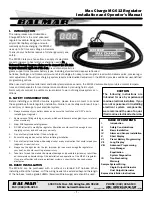
P3V Veterinary Digital Ultrasonic Diagnostic Imaging System User Manual
- 137
-
changed. Generally, the acoustic output will be higher with it gets nearer
to the probe.
Freeze
When freezing the system, it will stop transmitting ultrasonic wave.
Transmission power
The output of probe will be changed with the change of the transmission
power, and acoustic output will be changed.
Multi-frequency
The character of the wave focus will be changed with the change of the
frequency, and acoustic output will be changed.
Line density
The acoustic output will be changed with the change of the number of
the scanning line (line density).
PRF
The acoustic power will be changed with the change of PRF.
Sample volume
The pulsed wave and the power will be changed with the change of the
sample volume, and acoustic output will be changed.
Presets
Presets contain all the parameters above, so any change of the
presetting will change acoustic output.
Restart, or power on/off
System will return to the default setting when restarting, or powering
on/off the system, and acoustic output will be changed.
A2.3: Explanation of MI/TI
A2.3.1. MI (Mechanical Index)
Cavitations will be generated when ultrasound wave passes through and contacts tissues,
resulting in instantaneous local overheating. This phenomenon is determined by acoustic pressure,
spectrum, focus, transmission mode, and factors such as states and properties of the tissue and
boundary. This mechanical bioeffect is a threshold phenomenon that occurs when a certain level
of ultrasound output is exceeded. The threshold is related to the type of tissue. Although no
confirmed adverse mechanical effects on patients or mammals caused by exposure at intensities
typical of present diagnostic ultrasound instruments have ever been reported, the threshold for
cavitation is still undetermined. Generally speaking, the higher the acoustic pressure, the greater
the potential for mechanical bioeffects; the lower the acoustic frequency, the greater the potential
for mechanical bioeffects.
The AIUM and NEMA formulate mechanical index (MI) in order to indicate the potential for
mechanical effects. The MI is defined as the ratio of the peak-rarefactional acoustic pressure
(should be calculated by tissue acoustic attenuation coefficient 0.3dB/cm/MHz) to the acoustic
frequency.
MI
=
P
r,
α
f
awf
×
C
MI
C
MI
= 1 (MPa / MHz )
A2.3.2. TI (Thermal Index)
Heating of tissues is caused by absorption of ultrasound when the ultrasound energy is applied.
















































